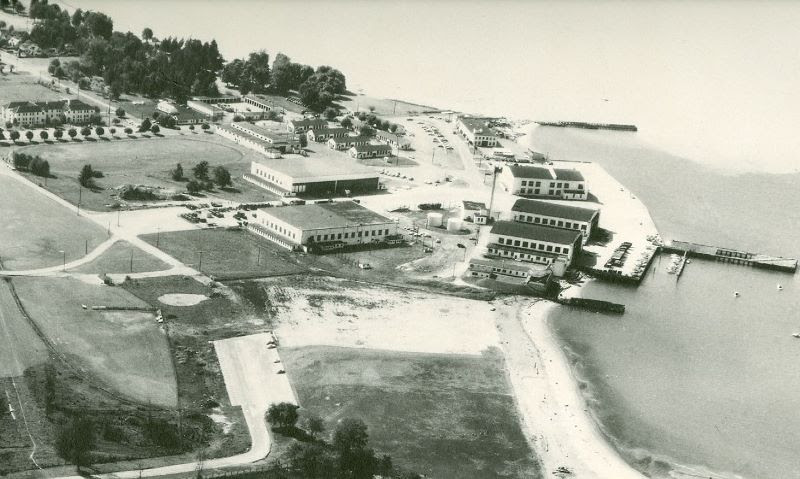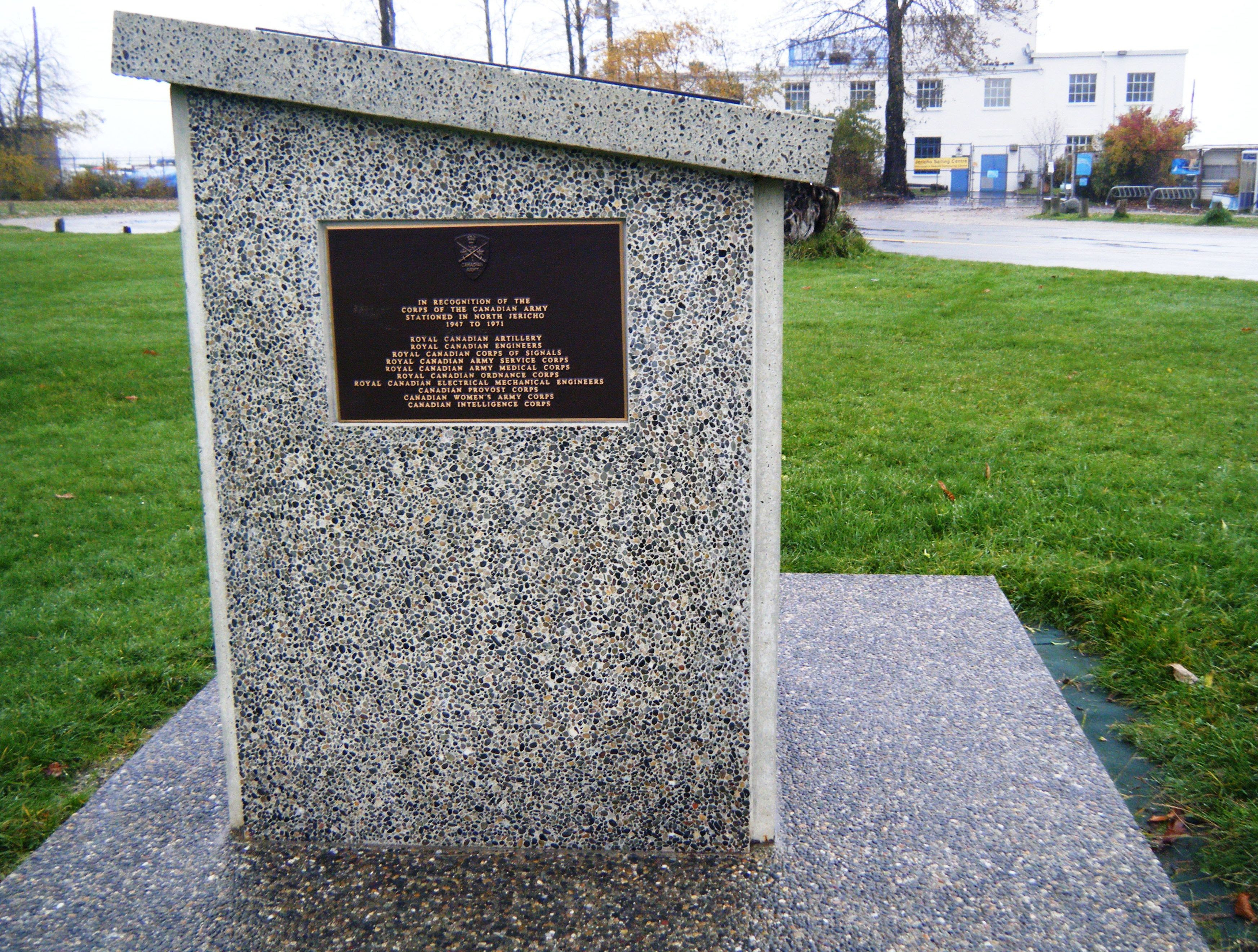Remembering the Jericho Beach Air Station
The bells that now toll here are wind whipped stainless halyards ringing a forest of anodized aluminum sailing dinghy masts; but it wasn’t always that way.
Department of National Defence Building 13, now known as the Jericho Sailing Centre, was a hustling, bustling place during the Second World War. Here, Canadians carried out their solemn duty to serve our country, to stand with honour to defend and preserve the freedom and way of life we cherish today.

What is now known as Jericho Beach Park and the adjacent lands south of 4th Avenue were all part of the largest military training base in western Canada, Canadian Forces Base Jericho Beach. The foreshore, which was hemmed with an apron of concrete wharves including 4 large airplane hangers and a Marine & Stores building (now the Jericho Sailing Centre), was RCAF Jericho Beach Air Station, a flying boat and seaplane base. Through the CFB Jericho Beach passed thousands of western Canadians in their metamorphic journey from civilians to soldiers, launched from here to the eternal hell that is war. Many never came home.
|
|
| Supermarine Stranraers on Patrol |
The Jericho Beach Air Station’s focus was civil defence; launching recognizance missions from this shore to patrol the BC coast, looking for signs of enemy vessels and/or aircraft. This original Jericho “ocean access facility” featured floating wooden launch ramps, steel wheeled launch dollies, winches, winch ropes, indoor flying boat storage, armed guards and barbed wire, lots of barbed wire.
The crews and personnel of Royal Canadian Air Force Squadron 4, launched flying boats and seaplanes; craft with names like: Blackburn Shark, Fairchild 71, Vickers MKII, Canso Catalina and the mainstay of the fleet, the Supermarine Stranraer – a sub hunter-nicknamed “the Whistling Birdcage” for the sound generated by it’s biplane wing shrouds and rigging in flight.
The wind and the sea were elements as important to those brave souls as they are to us today although their work was far more dangerous than our leisure time launches. A dead calm sea was difficult to take off from as the heavy craft’s hulls had to break through the salt laden surface tension to lift off. A sleeping sea was also treacherous to land on as it was impossible for sky skippers to judge altitude over a swiftly rising glassy surface. Larger waves could also be a problem. There were many spills; eleven aircrew lost in mishaps during this period. In one episode a Blackburn Shark’s pontoons punched head on into an English Bay rogue wave in the late stages of a takeoff, flipping the bird and killing the crew.
It may soothe the pacifist nature of our modern day users to know that in over 1700 wartime sorties the original crews of Jericho never fired a shot in anger and their only contact with the “other side” was a mysterious, ineffective, invasion of bomb rigged weather-type balloons in the winter of 1944/45.
 A monument, just south of the Jericho Sailing Centre entrance; the Jericho Hostel; Jericho Arts Centre; the Vancouver Park Board Maintenance compound, and the Jericho Sailing Centre are all that remain in Jericho Park in Remembrance of those flighty days and fearless crews. When the tubular bells of the Jericho Sailing Centre ring every November 11 they ring for all who served our country and particularly for those who served from these shores. Whenever we launch from Jericho we are exercising the freedom passed on to us from their weathered hands. Remember them well.
A monument, just south of the Jericho Sailing Centre entrance; the Jericho Hostel; Jericho Arts Centre; the Vancouver Park Board Maintenance compound, and the Jericho Sailing Centre are all that remain in Jericho Park in Remembrance of those flighty days and fearless crews. When the tubular bells of the Jericho Sailing Centre ring every November 11 they ring for all who served our country and particularly for those who served from these shores. Whenever we launch from Jericho we are exercising the freedom passed on to us from their weathered hands. Remember them well.
 What is now known as Jericho Beach Park and the adjacent lands south of 4th Avenue were all part of the largest military training base in western Canada, Canadian Forces Base Jericho Beach. The foreshore, which was hemmed with an apron of concrete wharves including 4 large airplane hangers and a Marine & Stores building (now the Jericho Sailing Centre), was RCAF Jericho Beach Air Station, a flying boat and seaplane base. Through the CFB Jericho Beach passed thousands of western Canadians in their metamorphic journey from civilians to soldiers, launched from here to the eternal hell that is war. Many never came home.
What is now known as Jericho Beach Park and the adjacent lands south of 4th Avenue were all part of the largest military training base in western Canada, Canadian Forces Base Jericho Beach. The foreshore, which was hemmed with an apron of concrete wharves including 4 large airplane hangers and a Marine & Stores building (now the Jericho Sailing Centre), was RCAF Jericho Beach Air Station, a flying boat and seaplane base. Through the CFB Jericho Beach passed thousands of western Canadians in their metamorphic journey from civilians to soldiers, launched from here to the eternal hell that is war. Many never came home.

 A monument, just south of the Jericho Sailing Centre entrance; the Jericho Hostel; Jericho Arts Centre; the Vancouver Park Board Maintenance compound, and the Jericho Sailing Centre are all that remain in Jericho Park in Remembrance of those flighty days and fearless crews. When the tubular bells of the Jericho Sailing Centre ring every November 11 they ring for all who served our country and particularly for those who served from these shores. Whenever we launch from Jericho we are exercising the freedom passed on to us from their weathered hands. Remember them well.
A monument, just south of the Jericho Sailing Centre entrance; the Jericho Hostel; Jericho Arts Centre; the Vancouver Park Board Maintenance compound, and the Jericho Sailing Centre are all that remain in Jericho Park in Remembrance of those flighty days and fearless crews. When the tubular bells of the Jericho Sailing Centre ring every November 11 they ring for all who served our country and particularly for those who served from these shores. Whenever we launch from Jericho we are exercising the freedom passed on to us from their weathered hands. Remember them well.